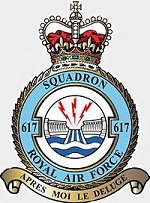Corgi AA32617 RAF Avro Lancaster B Mk. III Heavy Bomber - Wing Commander Leonard Cheshire VC, DV380, No.617 Squadron ("Dambusters"), RAF Scampton, 1943 (1:72 Scale)
"Never in the field of human conflict was so much owed by so many to so few."
- British Prime Minister Winston Churchill, commenting on the British airmen in the Battle of Britain
 Entering service at the beginning of 1942, the Lancaster's design grew out of a failed predecessor, the Avro Manchester. While its' airframe offered a stable platform for heavy bombing assignments, the Manchester's twin engine design was inadequate to the task. By upgrading to four Merlins, the resulting aircraft met the nation's needs and 7,366 Avro Lancasters were built during the war, the most of any British bomber. Armament included eight to ten Browning machine guns for fighter defense (depending on model variant) mounted in the nose, upper dorsal turret and the tail. Experience with a variety of bomb loads eventually led to adoption of the 'Grand Slam' 22,000-pound bomb, the largest carried by any aircraft in the war.
Entering service at the beginning of 1942, the Lancaster's design grew out of a failed predecessor, the Avro Manchester. While its' airframe offered a stable platform for heavy bombing assignments, the Manchester's twin engine design was inadequate to the task. By upgrading to four Merlins, the resulting aircraft met the nation's needs and 7,366 Avro Lancasters were built during the war, the most of any British bomber. Armament included eight to ten Browning machine guns for fighter defense (depending on model variant) mounted in the nose, upper dorsal turret and the tail. Experience with a variety of bomb loads eventually led to adoption of the 'Grand Slam' 22,000-pound bomb, the largest carried by any aircraft in the war.
The majority of Lancasters built during the war years were manufactured by Avro at their factory at Chadderton near Manchester and test flown from Woodford Aerodrome in Cheshire. Other Lancasters were built by Metropolitan-Vickers (1080, also tested at Woodford) and Armstrong Whitworth. The aircraft was also produced at the Austin Motor Company works in Longbridge, Birmingham later in the Second World War and postwar by Vickers-Armstrongs at Chester. Only 300 of the Lancaster B II fitted with Bristol Hercules engines were constructed; this was a stopgap modification caused by a shortage of Merlin engines as fighter production was of higher priority. Many BII's were lost after running out of fuel.
The Lancaster B III had Packard Merlin engines but was otherwise identical to contemporary B Is, with 3,030 B IIIs built, almost all at A.V. Roe's Newton Heath factory. The B I and B III were built concurrently, and minor modifications were made to both marks as new batches were ordered. Examples of these modifications were the relocation of the pitot head from the nose to the side of the cockpit, and the change from de Havilland "needle blade" propellers to Hamilton Standard or Nash Kelvinator made "paddle blade" propellers.
Of later variants, only the Canadian-built Lancaster B X, manufactured by Victory Aircraft in Malton, Ontario, was produced in significant numbers. A total of 430 of this type were built, earlier examples differing little from their British-built predecessors, except for using Packard-built Merlin engines and American-style instrumentation and electrics. Late-series models replaced the Frazer Nash mid-upper turret with a differently configured Martin turret, mounted slightly further forward for weight balance. A total of 7,377 Lancasters of all marks were built throughout the duration of the war, each at a 1943 cost of 45-50,000 (approximately equivalent to 1.3-1.5 million in 2005 currency).
For the dam-busting strike in May 1943, the Lancaster dropped British designer Barnes Wallis's 'bouncing bombs' which skipped on the surface before impact. Wartime Lancaster sorties totaled about 156,000 during which roughly 608,000 tons of ordnance were dropped on the enemy.
Pictured here is a 1:72 scale replica of a RAF Avro Lancaster B MkIII heavy bomber that was piloted by Wing Commander Leonard Cheshire VC, who was attached to No.617 Squadron ("Dambusters") during 1943.
Sold Out!
Dimensions:
Wingspan: 17-inches
Length: 11-3/4-inches
Release Date: December 2010
 Historical Account: "VC" - Leonard Cheshire took command of 617 Squadron in December 1943 and so keen was he to do this that he agreed to drop a rank to Wing Commander. Operational since June 1940, he had already completed three tours on Whitleys and Halifaxes earning the DSO and DFC. By the end of January 1944 though Cheshire was unhappy with the accuracy of the target making being provided to the Squadron and along with Squadron Leader 'Mick' Martin devised a plan to dive onto the target, in a four engined heavy bomber no less and accurately mark it from almost zero feet.
Historical Account: "VC" - Leonard Cheshire took command of 617 Squadron in December 1943 and so keen was he to do this that he agreed to drop a rank to Wing Commander. Operational since June 1940, he had already completed three tours on Whitleys and Halifaxes earning the DSO and DFC. By the end of January 1944 though Cheshire was unhappy with the accuracy of the target making being provided to the Squadron and along with Squadron Leader 'Mick' Martin devised a plan to dive onto the target, in a four engined heavy bomber no less and accurately mark it from almost zero feet.
Permission was given to test this method against the Aero Engine factory at Limoges, France on February 8th, 1944. Initially he buzzed the factory three times to warn the French workers of the raid and on his fourth run he released his markers from just 50ft right at the centre of the target.


